You can Download Chapter 8 Cell: The Unit of Life Questions and Answers, 1st PUC Biology Question Bank with Answers, Karnataka State Board Solutions help you to revise complete Syllabus and score more marks in your examinations.
Karnataka 1st PUC Biology Question Bank Chapter 8 Cell: The Unit of Life
1st PUC Biology Cell: The Unit of Life NCERT Text Book Questions and Answer:
Question 1.
Which of the following is not correct?
(a) Robert Brown discovered the cell.
(b) Schleiden and Schwann formulated the cell theory.
(c) Virchow explained that cells are formed from preexisting cells.
(d) A unicellular organism carries out Its life activities within a single cell.
Answer:
(a) Robert Brown discovered the cell.
Question 2.
New cells generate from
(a) bacterial fermentation
(b) regeneration of old cells
(c) prefix if ting cells
(d) abiotic materials
Answer:
(c) preexisting cells
Question 3.
Match the following
(a) Cristae – (i) Flat membranous sacs in stroma
(b) Cisternae – (ii) Infolding in mitochondria
(c) Thylakolds – (iii) Disc-shaped sacs in Golgi apparatus
Ans:
(a) – (ii)
(b) – (iii)
(c) – (i)
Question 4.
Which of the following is correct:
(a) Cells of all living organisms have a nucleus.
(b) Both animal and plant cells have a well-defined cell wall.
(c) In prokaryotes, there are no membrane-bound organelles.
(d) Cells are formed denovo from abiotic materials.
Answer:
(c) In prokaryotes, there are no membrane-bound organelles.
Question 5.
What is a mesosome in a prokaryotic cell? Mention the functions that it performs.
Answer:
Mesosome in a prokaryotic cell is a special membranous structure which is formed by the extensions of plasma membrane into the cell. They are essentially infolding of cell membrane. Functions of mesosome are:-
- They help in cell wall formation, DNA replication and distribution to daughter cells.
- They help in respiration, secretion process, to increase the surface area of the plasma membrane and enzymatic content.
![]()
Question 6.
How do neutral solutes move across the plasma membrane? Can the polar molecules also move across it In the same way? If not, then how are these transported across the membrane?
Answer:
Neutral solutes move across the plasma membrane by the process of simple diffusion along the concentration gradient i.e. from higher concentration to lower concentration. Movement of water by diffusion is called osmosis.
Polar molecules cannot move across the membrane by diffusion. They require a carrier protein of the membrane to facilitate their transport. Few ions or molecules are transported across the membrane against their concentration gradient i.e. from lower to higher concentration which is energy (ATP) consuming and is called active transport.
Question 7.
Name two cell-organelles that are double membrane-bound. What are the characteristics of these two organelles? State their functions and draw labelled diagrams of both.
Answer:
Cell organelles that are double membrane-bound are
- Mitochondria
- Chloroplasts
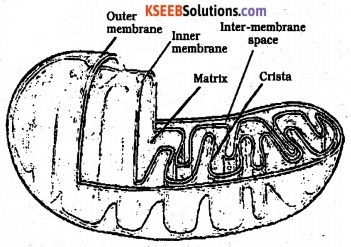
Its a double membrane-bound structure with the outer membrane and the inner membrane dividing its lumen distinctly into two aqueous compartments i.e. outer compartment and inner compartment. The inner compartment is called ‘matrix’. The inner membrane forms a number of infolding called the cristae towards the matrix. Two membranes have their own specific enzymes associated with the mitochondrial function.
Mitochondria are the sites of aerobic respiration.
They produce cellular energy in the form of ATP and called ‘power house’ of the cell. The matrix also possesses single circular DNA molecule, a few RNA molecules, ribosomes (FOS) and the components required for the synthesis of proteins.
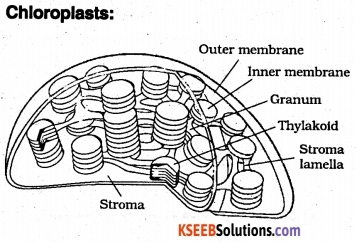
Chloroplasts are the plastids that contain chlorophyll pigments which are present in plant cells and euglenoids. The space limited by the inner membrane of the chloroplast is called the ‘stroma’. Stroma contains number of organised flattened membranous sacs called the thylakoids. Thylakoids are arranged in stacks called ‘grana’. Different grana are connected by flat membranous tubules called stroma lamellae. Space inside thylakoids is called lumen.
The stroma of the chloroplast contains enzymes required for the synthesis of carbohydrates and proteins. Its the site of dark reaction. Chlorophyll pigments are present in the thylakoids which along with carotenoid pigments are responsible for trapping light energy essential for photosynthesis. Grana is the site of light reaction.
Question 8.
What are the characteristics of prokaryotic cells.
Answer:
Characteristics of Prokaryotic cell
- Prokaryotic cells are smaller and multiply more rapidly than eukaryotic cells.
- They have cell wall surrounding the cell membrane and the fluid matrix filling the cell is the cytoplasm. They don’t have a well defined nucleus.
- Few prokaryotes like bacteria has additional small circular DNA called plasmids outside the genomic DNA. These plasmids confer unique phenotypic characters to such bacteria.
- Prokaryotic cell does not contain membrane bound organelles found in eukaryotes except ribosomes.
- A specialised differentiated form of cell membrane called mesosome are found in prokaryotes. These are membranous structure formed by the extensions of plasma membrane into the cell.
- Most prokaryotic cells like bacterial cells have chemically complex cell envelope consisting of tightly bound three layers viz. the outermost glycocalyx, the cell wall and the plasma membrane.
- Ribosomes, are made of two sub units 50s and 30s units which when present together form 70s prokaryotic ribosomes.
- Reserve material in prokaryotic cells are stored in cytoplasm in the form of inclusion bodies which lie free in the cytoplasm.
Question 9.
Multicellular organisms have division of labour. Explain.
Answer:
In Multicellular organisms, different group of cells perform different tasks in sustaining an ‘organism- Each group of cells perform a well defined task which is different from others but interact and co-operate with other cells. For eg: conduction by nerve cells, secretion by gland cells, red blood and white blood cells found in the blood etc. Thus multicellular organisms exhibit division of labour.
![]()
Question 10.
Cell is the basic unit of life. Discuss in brief.
Answer:
Every cell in an organism carries out all the biological activities independently. It releases energy by the breaking of food molecules. With this energy cell synthesizes complex molecules. Cells also play a major role in heredity. In plants, cells carry out photosynthesis. Each cell reproduces itself and has its own life cycle. The cell also regulates and maintains its own activities. So cell is considered a basic unit of life.
Question 11.
What are nuclear pores? State their function.
Answer:
At a number of places, the nuclear envelope is intercepted by minute pores which are called nuclear pores. These are formed by the fusion of two nuclear membranes. These nuclear pores are the passages through which movement of RNA and protein molecules takes place in both directions between the nucleus and the cytoplasm.
Question 12.
Both lysosomes and vacuoles are endomembrane structures, yet they differ in terms of their functions. Comment.
Answer:
Lysosomes are membrane bound vesicular structures formed by the process of packaging in Golgi apparatus. The isolated lysosomal vesicles have been found to be very rich in almost all types of hydrolytic enzymes like lipases, proteases, carbohydrates etc. These enzymes are capable of digesting carbohydrates, proteins, lipids and nucleic acids.
Vacuoles are membrane bound space found in cytoplasm. It contains water, sap, excretory product and other unuseful products of cell. It is bound by a membrane called tonoplast which facilitates the transport of number of ions and other materials against concentration gradient into the vacuole.
Question 13.
Describe the structure of the following with the help of labelled diagrams.
(i) Nucleus
(ii) Centrosome
Answer:
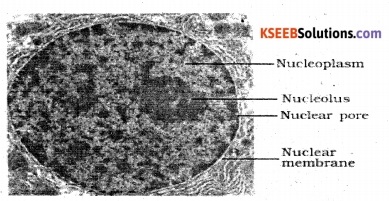
Nucleus contains nucleoprotein fibres called chromatin, nuclear matrix and one or more spherical bodies called nucleoli. It consists of two parallel membranes with space between them called the perinuclear space which forms the barrier between the materials present inside the nucleus and that of the cytoplasm. The outer membrane is continues with endoplasmic reticulum and bears ribosomes on it. Nuclear pores which are formed by the fusion of its two membranes are the passages through which movement of RNA and protein molecule takes
place in both directions. The content of nucleolus is continuous with rest of the nucleoplasm and it is a site for active ribosomal RNA synthesis. Chromatin contains DNA and some basic proteins called histones, some nonhistone proteins and also RNA.
(ii) Centrosome
Centrosome is an organelle usually containing two cylindrical structures called centrioles. They are surrounded by amorphous pericentriolar materials. Both the centrioles in a centrosome lie perpendicular to each other. They areV ma.de up of nine evenly spaced peripheral fibrils of tubular protein. Each of the peripheral fibril is a triplet. The adjacent triplets are also linked. The central part of the proximal region of the centriole is also proteinaceous and called the hub, which is connected with tubules of the peripheral triplets by radial spates made of protein.
Question 14.
What is a centromere? How does the position of centromere form the basis of the classification of chromosomes? Support your answer with a diagram showing the position of centromere on different types of chromosomes.
Answer:
Every chromosome has a region of primary constriction which is called the centromere. On the sides of centromere disc-shaped structures called kinetochores are present. Based on the position of centromere, the chromosomes can be classified into four types:
- Metacentric: This type of chromosome has middle centromere forming two equal arms of chromosome.
- Sub-Metacentric: This type has centromere slightly away from the middle of the chromosome resulting into one shorter arm and one longer arm.
- Acrocentric: In this chromosome the centromere is situated close to its end forming one extremely short and one very long arm.
- Telocentric: This chromosome has a terminal centromere.
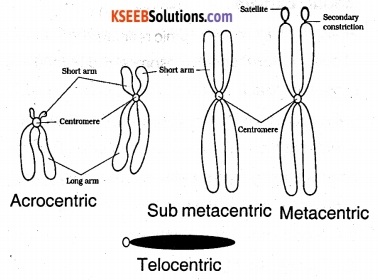
1st PUC Biology Cell: The Unit of Life Additional Questions and Answers
1st PUC Biology Cell: The Unit of Life One Mark Questions
Question 1.
Who proposed the cell theory?
Answer:
Schleiden and Schwann.
Question 2.
What is nucleoplasm?
Answer:
Fluid present inside the nucleus is called nucleoplasm.
Question 3.
How many layers are in nucleus?
Answer:
Two
Question 4
Who discovered Nucleus?
Answer:
Robert Brown
Question 5.
Which is the largest known cell?
Answer:
Egg of birds (Ostrich)
![]()
Question 6.
What are the chemical components of middle lamella?
Answer:
Calcium and Magnesium pectate.
Question 7.
Which is the smallest known cell?
Answer:
Mycoplasma gallisapticum.
Question 8
Who first used the term plastids ?
Answer:
A.F.W. Schimper.
Question 9.
Who proposed fluid Mosaic model of Plasma membrane. (Bijapur. 04)
Answer:
S.J. Singer and G.Nicolson.
Question 10.
What are plasmodesmata?
Answer:
The cytoplasmic connection between the cells is called Plasmodesmata
Question 11.
What is Rough/ smooth endoplasmic reticulum ?
Answer:
Endoplasmic reticulum with ribosomes is called Rough endoplasmic reticulum. Endoplasmic reticulum without ribosomes is called smooth endoplastic reticulum.
Question 12.
Name the membrane around Vacuole,
Answer:
Tonoplast. (B’lore South. 04)
Question 13.
Which is the site of dark reaction In Chloroplast?
Answer:
Stroma
Question 14.
What are Frets?
Answer:
Membranous links interconnecting the grana of the chloroplast are called frets.
Question 15.
Which is the site of light reaction in chloroplast?
Answer:
Grana (membranes of Thylakoids of grana)
Question 16.
What is granum?
Answer:
Membrane-bound flattened sacs appear like a pile of coins present in the stroma of chloroplast is called Granum.
Question 17.
Write two subunits of 70S ribosome / 80S ribosome.
Answer:
Subunits of 70s ribosome are 50s and 30s. Subunits of 80s ribosome are 60s and 40s.
Question 18.
What is the Svedberg unit?
Answer:
A measure of the size of a particle as determined by centrifugation and it is designated as ‘S’
Question 19.
What are Thylakoids ?
Answer:
Membrane bound flattened sacs of granum are called hylakoids.
Question 20.
Expand RER. (Gulbarga. 04)
Answer:
Rough endoplasmic reticulum.
Question 21.
Name the hard secondary cell wall material of conducting cells of plant body.
Answer:
Lignin.
Question 22.
Name the matrix of chloroplast.
Answer:
Stroma
Question 23.
Expand ATP.
Answer:
Adenosine Triphosphate.
Question 24.
Which cytoplasmic organelles are suicide bags called?
OR
Which cell organelle Is also called “Suicide bag” of cell? (Gulbarga. 2004)
Answer:
Lysosomes.
Question 25.
What is Chromatin?
Answer:
Darkly stainable thread-like structure found in the nucleus is called chromatin.
Question 26.
Name the powerhouse of the cell.
Answer:
Mitochondria. (Belgaum. 04)
![]()
Question 27.
What are crlstae?
Answer:
Folds of the inner membranae of mitochondria are called Cristae.
Question 28.
Name any one function of animal cell vacuole.
Answer:
Osmoregulation (in protozoans).
Question 29.
What is Tonoplast? (B’lore South. 04)
Answer:
The membrane covering the vacuole is called tonoplast.
Question 30.
Which is the controlling centre of the cell?
Answer:
Nucleus. (B’lore North. 04)
Question 31.
Which cell organelle in animals helps in the formation of aster fibres during cell division? (B’lore North. 2004)
Answer:
Centrosome with Centrioles.
Question 32.
Name the site of protein synthesis.
Answer:
Ribosomes. (Shimoga. 04)
Question 33.
Which is the Protein Factory of the cell?
Answer:
Ribosome (D.Kannada 2006)
Question 34.
What di shwann propose in his hypothesis?
Answer:
Shwann proposed that the bodies of animals and plants are composed of cells and product of cells.
Question 35.
Give any two organelles present in eukaryotic cell.
Answer:
Endoplasmic Reticulum, mitochondria.
Question 36.
What are the four basic shapes of bacteria?
Answer:
Bacillus (rod), coccus (spherical), vibrio (comma shaped) and spirillum (spiral).
Question 37.
What are plasmids?
Answer:
In addition to the genomic DNA, many bacteria have small circular DNA outside the genomic DNA called plasmids.
Question 38.
What are gram positive and gram negative bacteria?
Answer:
When bacterias are stained, few take up the gram stain and are called gram positive, others which do not are called gram negative.
Question 39.
What is bacterial flagellum composed of?
Answer:
Bacterial flagellum is composed of filament, hook and basal body.
Question 40.
What are inclusion bodies?
Answer:
Inclusion bodies are the reserve material in prokaryotic cells which are stored in cytoplasm.
Question 41.
How are lipids arranged in the plasma membrane?
Answer:
Lipids are arranged in the plasma membrane with the polar head towards the outer sides and the hydrophobic tails towards the inner part.
Question 42.
What are peripheral and integral proteins?
Answer:
Peripheral proteins are the membrane proteins which lie on the surface of the membrane while the integral proteins are partially or totally buried in the membrane.
Question 43.
What does fluid mosaic model state?
Answer:
According to fluid mosaic model, the quasifluid nature of lipid enables lateral movement of proteins within the overall bilayer.
Question 44.
What is passive transport?
Answer:
Movement of molecules across the plasma membrane without any requirement of energy is called passive transport.
Question 45.
What is active transport?
Answer:
A few ions or molecules are transported across the plasma membrane against their concentration gradient with the utilisation of ATP (energy). This transportation is called as active transport.
Question 46.
What is the composition of cell wall in plants?
Answer:
Cell wall is made of cellulose, hemicellulose, pectins and proteins in plants.
Question 47.
What is rough endoplasmic reticulum?
Answer:
The endoplasmic reticulum bearing ribosomes on their surface is called rough endoplasmic reticulum.
Question 48.
Who discovered Golgi apparatrs?
Answer:
Camillo Golgi.
Question 49.
What are Lysosomes?
Answer:
Membrane bound vesicular structures formed by the process of packaging in the Golgi apparatus are called lysosomes.
Question 50.
What does vacuole contain?
Answer:
Volume contains water, sap, excretory product and other materials not useful for the cell.
Question 51.
Why mitochondria is called powerhouse of the cell?
Answer:
Mitochondria is the site of aerobic respiration and produce cellular energy in the form of ATP. Hence, it is called as ‘power houses’ of the cell.
Question 52.
Name the three types of plastids?
Answer:
Chloroplasts, chromoplasts and leucoplasts.
Question 53.
Name the types of leucoplasts?
Answer:
Amyloplasts, elaioplasts and aleuroplasts.
Question 54.
What are leucoplasts?
Answer:
Leucoplasts are colourless plastids which store nutrients like carbohydrates, oils, fats and proteins.
Question 55.
What are ribosomes?
Answer:
Ribosomes are granular structure composed of ribonucleic acid (RNA) and proteins.
Question 56.
What is a hub?
Answer:
The central part of the proximal region of the centrio’s is called as the hub.
Question 57.
What does chromatin contain?
Answer:
Chromatin contains DNA and some basic proteins called histones, some nonhistone proteins and RNA.
Question 58.
What is a satellite?
Answer:
Non staining secondary constrictions at a constant location of chromosomes which
appear like a small fragment are called the satellite.
1st PUC Biology Cell: The Unit of Life Two Marks Questions
Question 1.
Write 4 differences between plant cell and animal cell. (Belgaum. 04)
Answer:
- Plant cells have cell wall Animal cells lack cell wall
- Plant cells contain Plastids Plastids are absent in Animal cells.
- Centrioles are absent in Plant cell. Centrioles are present in Animal cell.
- Vacuoles are large and well developed in plant cells. Vacuoles are small in animal cells.
Question 2.
Mention any two functions of Nucleus.
Answer:
- DNA present in the chromosomes is the primary hereditary material.
- Nucleolus of nucleus synthesize the necessary molecules required for the production of ribosome
- Biosynthesis of DNA and its replication occurs in Nucleus.
- RNA synthesis takes place in nucleus.
Question 3.
Write two functions of Centrlole.
Answer:
- Centriole plays important role in the initiation of cell division in animal cells.
- Modified centrioles are involved in the formation of locomotory organelles like cilia and flagella.
![]()
Question 4.
Draw the fluid mosaic model of plasma membrane and explain. (B. North 04, Tumkur2008)
Answer:
It is outer most layer in the animals most layer in the animal cell and in plant cell plasma membrane is present below the cell wall. Plasma membrane is also known as plasmalemma or cell membrane. The term plasma membrane was coined by Nageli and Crammer. It is composed by of lipid and protein hence the name lipoprotein membrane. To explain the structure of plasma membrane, several structural models have been proposed viz.

- Sandwich model of Danielli and Davson.
- Unit membrane model of Robertson.
- Fluid- mosaic model of Singer and Nicholson. Among these models the fluid mosaic model of Singer and Nicholson is widely accepted. According to this model lipid molecules are arranged in two layers with their hydrophilic ends facing the periphery and hydrophobic ends facing the center.Protein globules are dispersed in these lipid layers. The extrinsic proteins are found scattered on the inner and outer layers forming a mosaic. The intrinsic proteins are present within the lipid bilayer. Proteins show mobility and behave like icebergs floating in the sea.
Question 5.
State one function of
(a) Mitochondria
(b) Ribosome.
Answer:
(a) Mitochondria : It provides energy needed for the activities of the cell.
(b) Ribosome: They help in protein synthesis.
Question 6.
Write functions of plant cell wall?
Answer:
- Cell wall gives a definite shape to the cell.
- It protects the cell from mechanical damage and infection
- It helps in cell to cell interaction and provides a barrier to undesirable macromolecules.
- It provides rigidity and mechanical support to the cell.
Question 7.
What are unicellular organisms? Give examples.
Answer:
Organisms that contain only a single cell in their body are called unicellular organisms
e.g. amoeba, euglena, etc.
Question 8.
What are multicellular organisms? Give examples.
Answer:
Organisms that are made up of two or more cells are called multicellular organisms
eg: birds, fish, frog, etc.
Question 9.
What is gycocalyx? Give types of glycocalyx In bacteria.
Answer:
The outer most layer of the cell envelope in bacteria is called glycocalyx.
Two types of glycocalyx are:-
- Slime layer – which is a loose sheath
- Capsule – which is thick and tough.
Question 10.
Give the composition of bacterial flagellum. Which is the longest portion?
Answer:
Bacterial flagellum is composed of three parts, viz filament, hook and basal body. The filament is the longest portion and extends from the cell surface to the outside.
Question 11.
What are pill and fimbriae? What is its function?
Answer:
Pilli and fimbriae are surface structures of the bacteria. The pilli are elongated tubular structures made of special protein. The fimbriae are small bristle-like fibres sprouting out of the cell. The help in attaching the bacteria to the rocks and to the host tissues.
Question 12.
What is the importance of fluid mature of membranes regarding cell function?
Answer:
fluid nature of membrane is important from the point of view of functions like cell growth, the formation of intercellular functions, secretion, endocytosis, cell division, etc.
Question 13.
What is middle lamella? What is it made of?
Answer:
’Middle lamella is the layer of the cell wall that holds or glues the different neighbouring cells together. It is made of calcium pectate.
Question 14.
Differentiate between rough and smooth endoplasmic reticulum.
Answer:
| Rough ER | Smooth ER |
| (i) Contain ribosomes on their surface | (i) Do not contain ribosomes |
| (ii) Involved in protein synthesis and secretion | (ii) Involved in synthesis of lipids |
| (iii) Extensive and continuous with the outer membrane of nucleus | (iii) Not continuous with the outer membrane of nucleus. |
Question 15.
Differentiate between rough and smooth endoplasmic reticulum.
Answer:
| Rough ER | Smooth ER |
| (i) Contain ribosomes on their surface (ii) Involve in protein synthesis and secretion (iii) Extensive and continuous with the outer membrane of nucleus. |
(i) Do not contain ribosomes (ii) Involved in synthesis of lipids (iii) Not continuous with the outer membrane of nucleus. |
Question 16.
What is cisternae? Name two types of cisternae.
Answer:
Cisternae are the disc-shaped sacs found in Golgi apparatus. These are stacked parallel to each other. The cisternae are concentrically arranged near the nucleus with distinct convex ‘cis.’ or the forming face and concave ‘trans’ or the maturing face.
Question 17.
What are the functions of Golgi bodies?
Answer:
- It performs the function of packaging materials; to be delivered either to the intracellular targets or secreted outside the cell.
- Proteins synthesized by ribosomes on the endoplasmic reticulum are modified in the Golgi apparatus.
- It is the site of the formation of glycoproteins and glycolipids.
- Golgi cisternae form the primary lysosomes by budding.
Question 18.
Write short notes on
(a) Lysosomes
(b) Vacuoles
Answer:
(a) Lysosomes:
It is a membrane-bound vesicular structure formed by the process of packaging in the Golgi bodies. They are found to be very rich in hydrolytic enzymes like lipases, proteases, carbohydrases, etc. which help in digesting carbohydrates proteins, lipids and nucleic acids.
(b) Vacuoles:
Vacuole is the membrane-bound space found in the cytoplasm which contain water, sap, excretory product and other unwanted materials for the cell. It is bound by a single membrane called tonoplast. In plants, vacuoles can occupy 90% volume of the cell and tonoplast facilitates the transport of a member of ions and other materials against a concentration gradient into the vacuole.
Question 19.
What is cytoskeleton? What is its function?
Answer:
An elaborate network of filamentous proteinaceous structures present in the cytoplasm is collectively referred to as the cytoskeleton. The cytoskeleton are involved in many functions such as mechanical support, motility, maintenance of the shape of the cell.
1st PUC Biology Cell: The Unit of Life Three Marks Questions
Question 1.
Who proposed cell theory? Who modified it and what does it suggest?
Answer:
Cell theory was proposed by schleiden and Schwann. Rudolf virchow modified the hypothesis and explained the theory as:
- All living organisms are composed of cells and products of cells.
- All cells arise from preexisting cells.
Question 2.
Differentiate between prokaryotic and eukaryotic ceil.
Answer:
| Prokaryotic | Eukaryotic |
| (i) These cells lack membrane-bound nucleus and other membrane-bound organelles (ii) They have 70 S ribosomes (iii) They have plasmids in addition to genomic DNA (iv) They have special membranous structure called mesosomes (v) Gas vacuoles are present (vi) Cell wall is always present and made of peptidoglycan. |
(i) These cells have membrane-bound nucleus and other membrane-bound organelles (ii) They have 80 S ribosomes (iii) They have chromosomes which contain DNA (iv) They do not contain mesosomes (v) Sap/food/contractile vacuoles are present (vi) Cell wall is present in plants and absent in animals. |
Question 3.
What are inclusion bodies? Name all the types of inclusion bodies.
Answer:
Reserve material in prokaryotic cells are stored in the cytoplasm in the form of inclusion bodies. These are not bounded by any membrane system and lie free in the cytoplasm.
Phosphate granules, cyanophycean granules, glycogen granules and gas vacuoles are the types of inclusion bodies. Gas vacuoles are found in blue green and purple and green photosynthetic bacteria.
Question 4.
Write a short note on cilia and flagella.
Answer:
Cilia and flagella are hair-like outgrowths . of the cell membrane. Cilia are small structures which work like oars causing the movement of either the cell or the surrounding fluid. Flagella are comparatively longer and responsible for cell movement
Cilium and flagellum are covered by a plasma membrane. Their core called axoneme, pos-sesses a number of microtubules running parallel to the long axis. The axoneme has nine pairs of doublets of radially arranged peripheral microtubules and a pair of centrally located microtubules.
The central tubules are connected by bridges and is enclosed by a central sheath, which is connected to one of the tubules of each peripheral doublets by a radial spoke. The peripheral doublets are also interconnected by linkers. Both cilium and flagellum emerge from centriole like structure called the basal bodies.
1st PUC Biology Cell: The Unit of Life Five Marks Questions
Question 1.
Explain Fluid mosaic model Singer and Nicholson Model. (B’lore North 04)
Answer:
Singer and Nicholoson model of plasma membranes is called fluid Mosaic model.
According to this model lipid molecules are arranged in two lagers with their hydrophilic ends face the periphery and hydrophilic ends facing the centre. The protein globules are dispersed in there lipid layers. There are two types of proteins. The extrinsic proteins are found on the periphery arid intrinsic proteins are present within the lipid bilayer. Chain of carbohydrates are found attached to lipid or proteins. This model is a chemical model that explains the arrangement of lipids, proteins and carbohydrates in plasma membrane.
Question 2
Explain the structure of mitochondrion studied under electron microscope. (Gulbarga 2004, B’lore North 2004)
Answer:
Mitochondrion consists of two membranes say outer and inner. The outer membranes is entire but inner membrane has many inward projections called mitochondrial cristae. The space between outer and inner membrane is intermembrane space which continues into the space of cristae. On the surface of cristae there are many lollypop like F0F1 particles. Inner to the inner membrane, there is matrix, it consists DNA, ribosomes etc. The mitochondrial matrix is the site of Krebs cycle. The F0F1 particles contain certain enzymes and terminal oxidation occurs in this area.
![]()
Question 3.
With a neat labelled diagram explain the ultra structure of the chloroplast / plastid. (Gulbarga 2004, Belgaum 2004, D.K. 2005, Tumkur2005, Bangalore rural 2005)
Answer:

- Chloroplast is a plastid which contains the green coloured pigment chlorophyll.
- In higher plants they are discoid in shape and distributed abundantly in the mesophyll tissue of the leaf.
- They are bounded by a double layered unit membrane enclosing the inter membrane space.
- The inner membrane encloses a space called matrix (stroma matrix) made of carbohydrates, proteins, enzymes, nucleic acids and ribosomes.
- Lamellae differentiated as stroma lamellae (unstacked) and grana lamellae (stacked) are found in the matrix. The grana is made of several stacked membranes called thylakoids piled one above the other. They are connected by stroma lamellae/fret membranes and contain photosynthetic units called photosystems/quantasome containing photosynthetic pigments Chi ‘a’, Chi ‘b’, carotenes & xanthophylls.
Function:
Chloroplasts are main organelles helping in photosynthesis. The thylakoid membranes of granum contain chlorophylls. They harvest light energy and bring light reaction. The stroma of chloroplast consist of many enzymes required for Dark reaction.
Question 4.
Draw a neat labelled diagram of the ultra-structure of a typical animal cell.
Answer:
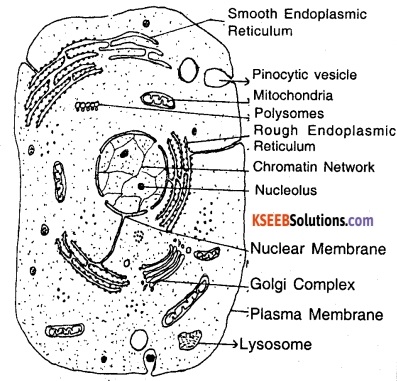
Question 5.
Describe the Fluid mosaic model of the Plasma membrane with a labelled sketch. (B’lore North 2004, M.Q.P.2005, B’lore rural 2005, Kolar2005, Hassan 2005, Mysore 2005, Udupi 2008, D.Kannada 2010)
Answer:
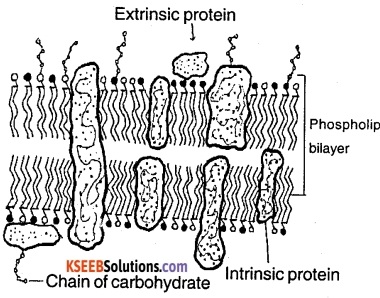
Singer and Nicholoson model of plasma membranes is called fluid Mosaic model.
According to this model lipid molecules are arranged in two lagers with their hydrophilic ends facing the periphery and hydrophilic ends facing the centre. The protein globules are dispersed in between the lipid layers. There are two types of proteins. The extrinsic proteins are found on the periphery and intrinsic proteins are present within the lipid bilayer. Chain of carbo-hydrates are found attached to lipids or proteins. This model is a chemical model that explains the arrangement of lipid, proteins and carbohydrates in plasma membrane.
Question 6.
Draw a neat labelled diagram of the ultra-structure of a typical plant cell.
Answer:
(Shimoga 2004, Chikmagalur 2004, M.Q.P. 2005, Kolar 2005, Mandya 2005, D.Kannada 2006,2007,2008, U.Kannada 2008)
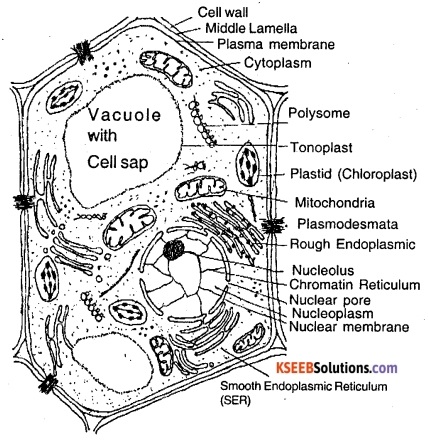
Question 7.
Describe the structure and functions of Golgi apparatus /Golgi complex.
(B’lore North, B’lore South. 05, Udupi 06)
Answer:
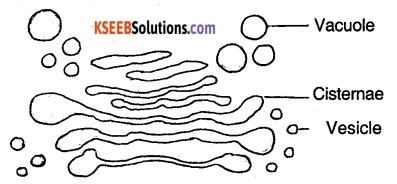
Golgi apparatus/Golgi bodies/Golgisome/ dictyosome was first discovered by Camillo Golgi in the nerve cells of the barn owls. They were called internal reticular apparatus. They are present everywhere, except the cells of prokaryotes, mammalian RBCs, mature sperms etc. The Golgi complex comprises of cisternae (which are flattened concave lamellae, larger towards the maturation phase and smaller towards the formation phase), tubules (minute tube like structures found as dialated structures towards the ends of the cisternae) and besides (sac-like structures that are spherical and pinched of from the cisternae). The membranes are unit membranes chemically made of lipo-protein and enclose vitamin C, fatty adds, enzymes etc.
Functions:
- They synthesize substances like mucopolysaccharides and enzymes.
- They produce secretory vesicles.
- They form the acrosomal cap of the sperm head.
- In plants cells they form the cell plate which forms the middle lamella.
Question 8.
Draw a neat labelled diagram of the following cell organelles and explain their structure.
(a) Mitochondria (Gulbarga, Belgaum 04, B’lore South, Hassan. 05, D.K. 2007)
(b) Centrioles (B’lore South, Hassan. 05)
Answer:
Cilium and flagellum are covered by a plasma membrane. Their core called axoneme, possesses a number of microtubules running parallel to the long axis. The axoneme has nine pairs of doublets of radially arranged peripheral microtubules, and a pair of centrally located microtubules.
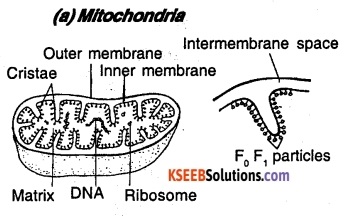
These were discovered by Kollicker in 1880. The word as coined by Benda. The shape of the mitochondria varies, are bounded by a double unit membrane, outer and inner enclosing a space called the intermembrane space. The outer membrane is smooth while the inner is thrown into folds called cristae. The surface of the cristae is provided with many Lolipop shaped F0F1 complexes or ATPases or Rackers particles helping in terminal oxidation. The central matrix contains enzymes, respiratory substrates, ATPs and nucleic acids. The matrix forms the site of the Krebs cycle.
Function:
Mitochondria are storehouses of energy, so-called ‘Powerhouse of the cell’. Since they contain DNA, they play a role in cytoplasmic inheritance.
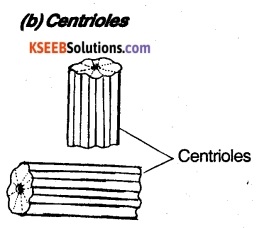
These were discovered by Van Banden in 1880. They are characteristic of animal cells only. The centrosome contains two cylindrical bodies called centrioles. They are arranged at right angles to each other: The cytoplasmic region forms the centrosphere. Each centriole shows a whorl of nine triplets of microtubules, embedded in an amorphous matrix and are parallel to each other but form an angle of 40°.
Function:
Centrioles help to organize the spindle fibres during cell division and form astral bodies & fibres the astral rays. In the sperm one of the centriole forms the axial filament
of the tail.
![]()
Question 9.
Mention the differences between plant cell and animal cell. (B’lore Rural, Mysore 05, D.Kannada. 07,2009)
Answer:
Plant cell – Animal cell
- Rigid cell wall of – (1) Cell wall is absent, cellulose
- Plastids are – (2) Plastids are absent characteristic
- Centrioles are – (3) Centrioles are present, absent
- Vacuoles are large – (4) Vacuoles are small prominent
- Storage product is (5) Storage product is starch
Question 10.
Write any one function of the cytoplasmic organelles
(a) Ribosome
(b) Endoplasmic reticulum
(c) Golgi body
(d) Nucleolus
(e) cell wall
Answer:
(a) Ribosome – Protein synthesis.
(b) Endoplastic Reticulum – Major site for synthesis of lipid.
(c) Golgi body – Site of formation of glycoproteins and glycolipids.
(d) Nucleolus – Synthesizes the necessary molecules for the production of ribosomes
(e) Cell wall – Gives shape and protects the cells from damage and infection.